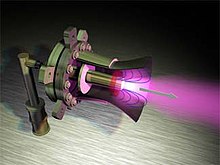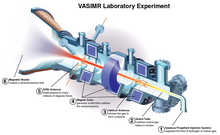Magnetoplasmic dynamic drive
A magneto-plasma-dynamic drive , and MPD-drive (engl. MPD thruster called), is a drive mechanism for space vehicles , which is based on the principle of electromagnetic acceleration. Due to the high electrical power requirement, however, only a few drives have been tested in space since development began in the 1960s, in particular through efforts by Japan and the former Soviet Union.
It uses the Lorentz force , which describes the interaction between a magnetic field and electrical current, and is therefore also called the Lorentz Force Accelerator (LFA). MPD drives represent a further development of the thermal arc engine (Arcjet), the electrothermal acceleration of which is replaced by the more efficient electromagnetic acceleration. As a result, a higher degree of efficiency can be achieved, but this is only achieved with high power and the associated strong magnetic fields. If a magnetic field is also applied, it is referred to as an external field accelerator ( AF-MPD; Applied-Field MPD ), otherwise it is referred to as a self-field accelerator ( SF-MPD; Self-Field MPD ).
technology
MPD engines consist of a funnel-shaped anode with a rod-shaped cathode in the middle . If an electrical voltage is applied between the two electrodes , the supporting mass in the funnel is ionized and thus allows a current to flow radially through the gas to the cathode. A strong magnetic field is now generated by the current flow. The interaction between the electrically generated magnetic field around the combustion chamber and the ionized support mass accelerates it in the axial direction and allows it to escape at a very high speed. The pushing force is created by the momentum that is effective .
Argon , lithium and hydrogen are particularly suitable as the basis for the plasma . In test laboratories, exit speeds of 144,000 km / h (40 km / s) have already been achieved with an MPD drive using an external magnetic field.
VASIMR
A variant of the magnetoplasma dynamic drive is being developed by the US company Ad Astra Rocket Company . The director is the former seven-time NASA astronaut and plasma physicist Franklin Ramon Chang-Diaz , who developed the concept back in 1979 while working at MIT .
In VASIMR or variable specific impulse magneto plasma rocket carried
- the generation of the plasma,
- its further heating and
- Acceleration in the nozzle
in three separate chambers.
This allows the ratio between specific momentum and thrust to be varied, analogous to the gear shift of a wheeled vehicle . A spacecraft could use it to generate high thrust to leave the gravitational field of a planet and then cover a longer distance at high speed.
VASIMR could thus offer significantly higher efficiency than conventional spaceship propulsion systems, shorten travel times during space flight within the solar system to monthly or even weekly periods and thus also make it practicable for humans. The travel time Earth-Mars would be shortened from more than 180 days to 39 days.
Current state of development
The US company Ad Astra is the developer of VASIMR and is currently working on increasing the overall efficiency by increasing its output; accordingly, 67% are currently achieved. The publications about the VX-50 unit, which uses 50 kW radio wave power, calculate an efficiency of almost 59% as follows:
The VX-100 model is said to achieve an overall efficiency of 72% by improving the N B ion speed boosting efficiency to 80%.
In October 2008, the company reported that the VX-200 helicon engine was operational in the first stage, a solid-state high frequency power coupler . The key technology for this, direct current radio wave conversion (solid-state DC-RF), achieves an efficiency of 98%.
The Helicon discharge here uses 30 kW radio waves to generate an argon plasma. The other 170 kW are used to accelerate the plasma in the second section, for which purpose ion cyclotron resonance heating (see also cyclotron resonance ) is used.
ISS deployment
On December 10, 2008, Ad Astra Company received an order from NASA to install and test a ready-to-use VF-200 engine with 200 kW of power on the International Space Station (ISS). With the VF-200 engine, the height of the station can be maintained without having to carry large amounts of rocket fuel to the ISS again and again. The launch was not expected until 2014, and then planned for 2015 according to a publication by Ad Astra. Because of the high power consumption, VASIMR should work in pulse mode, whereby the 15-minute load cycles should be buffered by batteries. As part of NASA's Next Space Technologies for Exploration Partnerships (NextSTEP) program, these plans were put on hold for the time being in favor of a further development of the propulsion system (see below).
Based on tests of the predecessor VX-100, the VF-200 engine is expected to achieve an efficiency of 60–65% and a thrust of 5N. The optimal specific impulse is expected around 5000 s, this when using relatively cheap argon. The specific power is estimated at 1.5 kg / kW, which means that this VASIMR engine weighs around 300 kg.
Between April and September 2009, further tests were carried out on the VX-200 prototype with integrated superconducting magnets. This enabled the expansion of the power range to be shown to the application power of 200 kW.
Further collaboration between NASA and Ad Astra
On March 31, 2015, Ad Astra announced that it had been awarded the contract for a further development of the VASIMR drive as part of NASA's NextSTEP program with a volume of almost 10 million US dollars over three years. Ad Astra hoped to achieve a Technology Readiness Level greater than 5 (TRL 5) for an engine with more than 100 hours of continuous running time by 2018 . Further tests could take place later in space.
Energy source
The greatest challenge with MPD and VASIMR developments is the generation of electrical power , which would be in the megawatt range in sensible applications. A conversion from chemical energy would lower the overall efficiency below the level of chemical drives; Solar panels or isotope batteries do not achieve this level of performance in the sizes that have been common up to now. The plans therefore rely on nuclear fission or nuclear fusion as future energy sources for space propulsion.
See also
Web links
- General explanation - Institute for Space Systems of the University of Stuttgart
- Technology Review: To Mars and Much Further - Interview with Diaz about VASIMR
- Ad Astra Rocket Company - developer of the VASIMR
- Press release on the status of the VASIMR-VX-200 prototype (PDF file; 91 kB)
- heise.de Newsticker - "Competition for rocket propulsion"
- Naone, E .: To Mars and much further. Technology Review, September 28, 2007
- Hall-effect electrostatic engine ( Memento from September 15, 2007 in the Internet Archive )
Individual evidence
- ↑ Online science journal The Register of October 28, 2008: Plasma rocket space drive in key test milestone: Nuke tech could carry astronauts beyond Mars
- ↑ Recent Improvements In Ionization Costs And Ion Cyclotron Heating Efficiency In The VASIMR Engine (PDF; 1.3 MB) Retrieved January 11, 2011.
- ↑ High Power VASIMR Experiments (PDF; 817 kB) Accessed January 11, 2011.
- ↑ Press Release: VASIMR VX-200 first stage achieves full power rating. (PDF; 729 kB) Retrieved January 11, 2011.
- ↑ Thomas Hofstätter: Plasma propulsion could revolutionize space travel. raumfahrer.net, June 10, 2010, accessed on December 17, 2013 .
- ^ The ISS Space Plasma Laboratory: A Proposed Electric Propulsion On-Orbit Workbench. (PDF; 2.7 MB) October 6, 2013, accessed on February 19, 2014 .
- ^ NASA Announces New Partnerships with US Industry for Key Deep-Space Capabilities. March 30, 2015, accessed September 10, 2015 .
- ↑ Article: VASIMR Performance Measurements at Power Exceeding 50kW and Lunar Robotic Mission Applications. (PDF; 1.6 MB) Retrieved January 11, 2011.
- ↑ Press Release 011009, September 30,2009: VASIMR® VX-200 reaches 200 kW power milestone. (PDF; 331 kB) Retrieved January 11, 2011.
- ↑ AD ASTRA ROCKET COMPANY WINS MAJOR NASA ADVANCED PROPULSION CONTRACT. (PDF; 90 kB) March 31, 2015, accessed on September 10, 2015 .
- ↑ Aethera Technologies Limited and Canadian Space Agency sign $ 1.5M R&D agreement boosting Ad Astra Rocket Company's VASIMR development. In: Aethera Technologies. June 26, 2018, accessed December 18, 2018 .
- ↑ Exclusive interview with Ad Astra Rocket , May 27, 2019.



